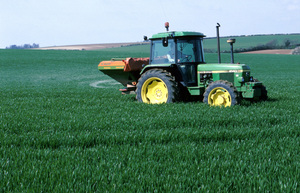The main focus of Rothamsted when it was set up in 1843 was to improve fertiliser practice. So it’s sobering to reflect on where we are nowadays with nitrogen recommendations for crops.
The depressing fact is that, as an industry, we haven’t got much further. In winter wheat, at best we can only predict within 50 kg/ha of optimum fertiliser N in 75% of cases, even where there’s not much N in the soil; i.e. long term arable soils with low organic matter and where no organic manures are used.
This sounds unimpressive, but the other methods of prediction are far worse. And they are even less reliable when it comes to predicting optimum fertiliser N rates where there’s a good bit of nitrogen already kicking about the system.
But why?
It’s hard to blame the scientists at the blue sky end of the research spectrum. Nitrogen cycling in the soil is a terrifyingly difficult subject, even with the advantages of modern research techniques. In addition, the optimum fertiliser N requirement can be influenced by weather after application.

Personally I consider that some progress has been lost at the more practical end of research, because there was an aura that it had all been resolved. We had nice tables in RB209 that implied there was accuracy. Measuring soil mineral nitrogen implied even greater accuracy. However, some of the simple assumptions that are behind these prediction methods may be flawed. Scientists charged with improving recommendations need to look at all the recent evidence and to see if things can be improved.
With this background in mind I was excited to read, and analyse, the HGCA project report PR447 on canopy management of winter oilseed rape. There was a remarkably (for nitrogen trials) close relationship between N in the canopy, involving laboratory N analysis, in the spring and optimum N fertiliser requirement. Perhaps this relationship was even more remarkable when the fickleness of the oilseed rape crop is taken into account.
However, this relationship was made worse when soil mineral nitrogen was also taken into account. The same occurred in trials on canopy management in Germany’s Schleswig Holstein.
We now know the possible pitfalls when trying to accurately measure soil mineral nitrogen. Additionally, the assumptions used to predict the impact of soil mineral nitrogen on crop fertiliser N requirement may be erroneous.
However, it is clear that another stumbling block is getting a practical field method that provides an accurate estimate of N in the canopy.
There are electronic methods of estimating canopy size which can lead to a reliable estimate of the total N in the canopy. However, the ability to predict the optimum economic dose of applied N is much reduced when compared to the method that involves plant analysis.
So, perhaps, history repeats itself. Have we here an improved method of prediction, but it is not reaching its full potential because of underlying assumptions? Perhaps only a researcher will say this, but we need more R&D on this issue...
